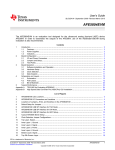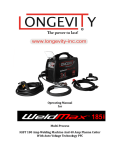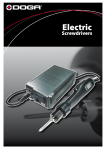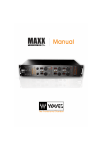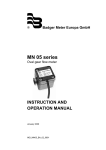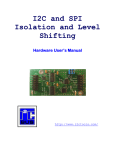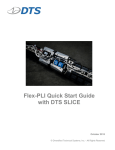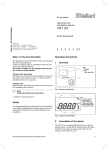Download TSN75E Power Supply Manual
Transcript
Installation / Operation / Maintenance StaticControls TSN75E User Manual 7.5kV Static Neutralizing Power Supply General Description The Static Clean Static Neutralizing System consists of two parts: • A high-voltage line-frequency (50/60Hz) transformerbased AC Power Supply • An Applicator (air ionizer in the form of a bar or rod, air blower, air gun, air nozzle, or air knife). The system is designed to create an abundance of bipolar air ions in a “field” which tends to neutralize electrically charged materials (paper, plastic, glass, wood, etc.) that pass through it. The Static Neutralizing Power Supply The TSN75E Power Supply is an output-current-limited AC-voltage source, providing appropriate ionization at the Applicator and safety to the user. An internal step-up transformer operates off the mains, and its high-voltage (HV) secondary is coupled to the Output Ports through a resistive damping circuit; the Resistive Output Coupler provides optimal voltage limiting and load regulation with a wide range of Applicator equipment, enhancing the reliability of the Neutralizing System. The TSN75E includes a dual-voltage selector switch to support operation with a multitude of international mains power systems. Locating the Power Supply Locate the Power Supply as close as possible to the applicator using its mounting flanges to securely fasten the unit in place. Choose a location free of oil, water and contamination. T h e P o w e r S u p p l y a n d a t t a c h e d Applicator(s) must not be located outside where they might be exposed to rain, snow and other elements . Avoid areas where ambient temperature is continuously in excess of 49°C/120°F. Mount the Power Supply so that the HV Output Ports are facing down or to either side to prevent entry of foreign material. Unless specified differently in the purchase order, each static bar is equipped with an integral standard 6-ft. (1.8m) length of HV cable. This length allows the installation of two static bars up to 10 ft. (3m) apart connected to one centrally-located Power Supply. Slack (i.e. excess length) in the HV cable can be eliminated by coiling, using a minimum number of turns to avoid excess stress/strain and degradation of dielectric strength in the insulation of the cable, possibly leading to early failure. Grounding the Power Supply For safety and reliable function, the TSN75E Power Supply must be grounded through both mains connection (i.e. IEC-320 connector) and chassis protective-earth (PE) connection. The PE connection must be made between the ground stud (located in the lower-center area of the I/O panel) and a reliable and properly tested electrical earth (e.g. mounting stud or similar equipment attachment location). CAUTION: IT IS IMPORTANT THAT ONLY QUALIFIED PERSONNEL FAMILIAR WITH HANDLING HIGH VOLTAGE ELECTRICAL EQUIPMENT BE TRUSTED TO INSTALL, SERVICE, AND TROUBLESHOOT THIS EQUIPMENT. FEEL FREE TO CONSULT THE FACTORY IF YOU HAVE ANY QUESTIONS. Static Clean International • 15 Adams St., Burlington, MA 01803 Tel: 781-229-7799 Fax: 781-229-4555 • www.staticclean.com 10/12 Installation / Operation / Maintenance StaticControls Model TSN75E Specifications Mounting the Power Supply The TSN75E Power Supply provides two mounting flanges on opposing sides of the chassis. Each flange includes two slotted holes and one open-end slot, supporting a range of screw locations in both axes on the mounting plane. Using the dimensions herein provided, drill and tap two or four mounting holes (10-32 or 1/4-20 are adequate to secure the Power Supply). The preferred Power Supply orientation is with the I/O panel face down; face left or right is acceptable. The Power Supply must not be oriented with the I/O panel face up. Avoiding this will prevent contaminants traveling down the HV cable and into the Output Port sockets, possibly generating a parasitic conductive path overloading the supply or overheating and degrading HV insulation materials. Looping of the HV cable below the height of the Output Ports is also recommended to divert fluids away from the HV sockets. Power Supply Input Voltage 2 The TSN75E Power Supply dual-voltage selector enables the user to connect the input to single-phase, 50/60Hz mains power at 120VAC or 240VAC (lower mains voltages generate proportionally lower output voltage in the TSN75E and other “linear transformer” power supplies). A detachable three-conductor line cord with a 115V ground-prong plug is supplied with the unit. Be sure to plug the cord into a grounded three-prong receptacle (alternatively, the plug can be cut from the cord so that the pigtail can be “hard-wired” if desired). Line cords with US, UK or Euro 230V plugs (sold separately) are available and must be specified at the time of order. VERY IMPORTANT – Before connecting mains power to the unit, be sure to check or set the voltage selector switch (located above Output Ports on I/O panel) to the proper position -- either 120V (115V) or 240V (230V). Failing to correctly set the switch can damage or destroy the Power Supply, increase risk of shock to operators and/or void the warranty. Remember: Proper input-grounding of the TSN75E Power Supply is essential to the safety of the user and proper operation of the equipment. A power cord with a ground prong as supplied (or equivalent wiring) must be used to assure that the Power Supply is grounded. For added convenience and safety, these units come equipped with a fuse and a lighted on/off switch. A spare fuse is included, stowed inside the removable fuse drawer. Routing the Applicator HV Cable The Applicator HV cable may be sheathed in a conductive shield or in a non-conductive flex-tube, or unsheathed. Unsheathed cable must be dressed, mounted and routed so as to guarantee a minimum (solid or air) dielectric spacing of 1/4 in. between all points on the cable insulator and all other conductive surfaces and objects (including metal mounting hardware and mounting-surface corners). A minimum bending radius (referenced to wire centerline) of 1 1/4 in. applies to all cables. Special care should be taken to assure the HV cable will not be subjected to tugging, snagging, pinch-points or moving parts that may cut, nick, abrade or wear-down the cable insulation and/or sheathing. Failure to follow the above-described precautions will likely result in premature failure of the HV cable and void the warranty. Connecting Applicator to Power Supply Applicator HV cables can be configured for various features such as shielding, jacketing and termination styles. The following are standard feature combinations requiring either a two-wire connection (i.e. HV and ground) or a one-wire connection (i.e. HV only) to the Power Supply: Set Screw Cable Nut Spacer Spring Contact • shielded HV cable with a braided-wire sleeve ground conductor fully enclosing the HV cable or a standard/discrete-wire ground conductor alongside a protective flex-tube jacket enclosing the HV cable (twowire connection) • unshielded HV cable with or without a protective flextube jacket (one-wire connection; for unjacketed configuration see the following section on terminator-plug assembly procedure) FOR SAFETY – Before proceeding verify that the mains is disconnected and that the TSN75E is unpowered. 1. Fully insert Applicator HV cable plug connector(s) into TSN75E Output Port socket connector(s) after removing dust covers, if present. 2. Thread retaining nut(s) into Output Port socket(s) and finger-tighten. Do not use tools! 3a. For shielded HV cable, remove outer (1 of 2) 8-32 hex nut (with star washer) from the TSN75E ground stud. Place ring terminal(s) of HV-cable ground/shield (green or black) wire(s) over TSN75E ground-stud (and PEwire terminal). Replace and tighten hex nut. This connection grounds the HV cable shield (to minimize EMI) as well as the Applicator(s) ground/reference electrodes. 3b. For unshielded HV cable (note: not recommended for EMI-sensitive applications), connection of the Applicator(s) ground/reference electrodes must be made by wire (e.g. to TSN75E ground stud or alternative earth location) or directly (through conductive mounting hardware if applicable). Applicator ground/reference wiring or mounting connection points vary with different forms of ionizing equipment. Examples include: • mounting (i.e. bolt-head) slot in aluminum “outer bar” shell of a static bar • tip of an ionizing air-nozzle 4. Verify that TSN75E dual-voltage selector switch, located above HV Output Port sockets on I/O panel, is set to match mains voltage (100V...120V or 200V...240V). 5. After Applicator(s) and Power Supply have been properly installed, secured and grounded, mains power may be connected (e.g. plug the power supply line cord into a properly grounded 3-wire AC outlet). Verify that mains voltage and frequency match those specified on TSN75E nameplate. Do not remove ground prong or ground wire from the line-cord or use a three-to-two prong adapter. HV Cable Termination Using Plug Connector Kit (unshielded unjacketed HV cable only) After mounting Applicator(s) and Power Supply, routing HV cable(s) and cutting to desired length, attach HV cable connector as follows (refer to figure at top-left of page for kit parts illustration): 1. Slide retaining nut over cable with threaded section trailing (i.e. facing the cable end). 2. Slide spacer over cable. 3. Carefully strip 3/16 in. to 1/4 in. of insulation from end of HV cable, exposing conductor. 4. Insert conductor into entry hole in base of spring contact. 5. Tighten set screw in base of spring contact (use 1/16in. Allen wrench) until conductor strands are held firmly in place. Installation / Operation / Maintenance 7.5 kV Static Neutralizing Power Supply Specifications: TSN75E Type: high-voltage linear transformer with resistive output coupling Input Voltage: Frequency: Output Voltage: Input Current: Input Fusing: Output Current: Ambient Temperature: Line Cord: Optional Cords: Weight: Dimensions: . . . . . . . . .120/240 VAC . . . . . . . . .50/60 Hz . . . . . . . . .7.5 kVRMS nom. . . . . . . . . .0.2/0.1 A max. . . . . . . . . .0.315 A time-delay . . . . . . . . .3 mA max. . . . . . . . . .< or = 40C . . . . . . . . .6’ detachable with NA 3-prong grounded plug . . . . . . . . .UK, Euro, and NA 240V grounded plugs available . . . . . . . . .6.0 lb width: . . . . . .6.8 in. height: . . . . . .4.2 in. depth: . . . . . . .6.9 in. 3 Maintenance Both the TSN75E Power Supply and the Applicator must be kept clean and free of water, oil, grease, solvents and other contaminants. Contamination or arc-over in the “Applicator” can degrade the longevity and reliability of the Static Neutralizing System. Troubleshooting Only a qualified person familiar with handling HV equipment should attempt to troubleshoot and service this equipment. • Power-off system (i.e. disconnect mains) and disconnect all applicators. • Confirm that grounds are reliable and secure. • Confirm mains voltage and frequency are within specifications. • Confirm that dual-voltage selector switch setting is correct for the verified mains voltage. • If the switch was set to 240V (230V) and the mains voltage is in lower range (100V...120V), change the switch setting to 120V (115V) and power-on the unit. If this does not correct the problem, consult the factory. • If the switch was set to 120V (115V) and the mains voltage is in higher range (200V...240V), the input fuse (located inside the removeable fuse drawer beside the inlet connector) must be replaced. A spare fuse is also located in the fuse drawer. Discard the original fuse and replace with the spare fuse, change switch setting to 240V (230V) and power-on the unit. If this does not correct the problem, consult the factory. • Confirm fuse continuity (visually or, preferrably, by ohmic testing). Replace if necessary. • Confirm that the power switch is ON. Please also note that HV test attenuators/probes may significantly load high-impedance nodes (e.g. “shockless” ionizing electrodes) within a Static Neutralizing System, resulting in measured voltages much lower than those during normal (i.e. unloaded or unprobed) operation. For further assistance, please consult us at our factory. Phone: 781-229-7799 Fax: 781-229-4555 Operation Before applying mains power, be sure that the TSN75E Power Supply is secure in its mounting, all ground and highvoltage connections are reliably made and secure, mains voltage and frequency are appropriate and that the “Applicator” is clean and correctly installed. Apply mains power and set the TSN75E power switch to the ON position. Servicing and Repairing Power Supply In-the-Field In the event of damage to or failure of a power-supply component, the user may choose to repair the TSN75E Power Supply at his facility or to send the unit to the factory for repair. For in-the-field repair, please refer to the TSN75E Service and Repair Manual for replacement component part numbers, pricing, etc. and instructions. Static Clean International • 15 Adams St., Burlington, MA 01803 Tel: 781-229-7799 Fax: 781-229-4555 • www.staticclean.com 4




